TOP 12 Candlestick Patterns - Essential Ways to Read Japanese Candlestick Charts

Candlestick patterns, also known as Japanese candlestick charts, are a widely used technical analysis tool for describing the price movements of securities, derivatives, or Forex. From the beginning of my trading journey until now, I have learned about approximately 40 types of candlestick patterns.
In this article, I will provide readers with detailed knowledge about Japanese candlestick patterns, especially the top 12 basic candlestick patterns, as well as the essential methods for reading and analyzing Japanese candlestick charts that every trader needs to know.
1. What are Japanese Candlesticks Patterns?
Japanese candlestick patterns originate from Munehisa Homma, an 18th century Japanese rice trader. Homma developed candlesticks that represented the nature of price movements using different colors to signify the differences.
This allows traders to use the candlesticks to identify price action patterns and make decisions based on the short-term price trends.
Over a specific time period, candlestick patterns display a security's highest, lowest, opening, and closing prices. The candlestick's wicks display the highest and lowest prices of the day, as well as how they compare to the open and close. The candlestick's shape will change depending on the relationship between the highest, lowest, open, and close prices during the day.
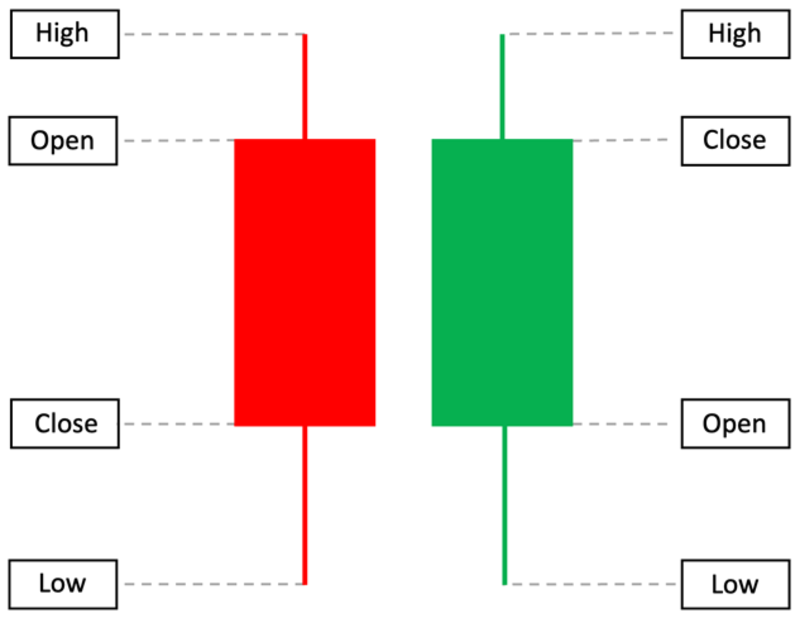
Source: Researchgate
Anatomy of a Japanese Candlestick:
Upper Wick: The vertical line between the highest price and the close (if it's a bullish candle) or the open (if it's a bearish candle)
Body: The difference between the open and close prices; the colored portion of the candle
Lower Wick: The vertical line between the lowest price and the open (for a bullish candle) or the close (for a bearish candle)
Two main types of candlesticks patterns:
Bullish candlesticks patterns - Appears when the close is higher than the open, usually colored green (or white).
Includes patterns like Hammer, Inverted Hammer, Bullish Engulfing, Piercing Line, Morning Star, Three White Soldiers.
Bearish candlesticks patterns - Appears when the close is lower than the open, usually colored red (or black).
Includes patterns like Hanging Man, Shooting Star, Bearish Engulfing, Evening Star, Three Black Crows, Dark Cloud Cover.
2. How to Read Candlestick Charts (Candlestick Analysis)
On Japanese candlestick charts, each candlestick represents the open, high, low, and close prices for the time frame chosen by the trader.
For example, if a trader sets a 5-minute time frame, a new candlestick will be created every 5 minutes. In this example, the open and close prices are the prices at the start and end of the 5-minute period.
Looking at the chart in Figure 1 above, we can see:
Open Price: The candlestick body's upper or lower end indicates the open price, depending on whether it increased or decreased during the 5-minute period.. If the price trend is up, the candlestick is usually green or white with the open at the bottom.
Conversely, if the price trend is down, the candlestick is usually red or black with the open at the top.
High Price: The top of the upper shadow represents the high price during the candlestick period. . If the open or close is the high price, there will be no upper shadow.
Low Price: The low price is indicated by the bottom of the lower shadow. If the opening or closing price is low, there will be no lower shadow.
Close Price: For green (white) candlesticks, the top of the body represents the closing price, and for red (black) candlesticks, the bottom of the body represents the closing price.
As a candlestick forms, it continuously changes as the price moves. The open price remains constant, but the high and low prices will continuously change until the candlestick is complete.
The color of the candlestick may also change, transitioning from green to red. When the time period for the candlestick ends, the final price is the closing price, the candlestick is complete, and a new candlestick begins.
Above is an online candlestick chart. Please try to read the candlestick chart according to the contents mentioned above! If you want to view the daily candlestick chart along with technical indicators, you can take a look at the Mitrade trading platform.
Time frame of the daily candlestick chart
A daily candlestick chart will consist of multiple candles, and each chart will represent a specific time frame. The most common time frames include:
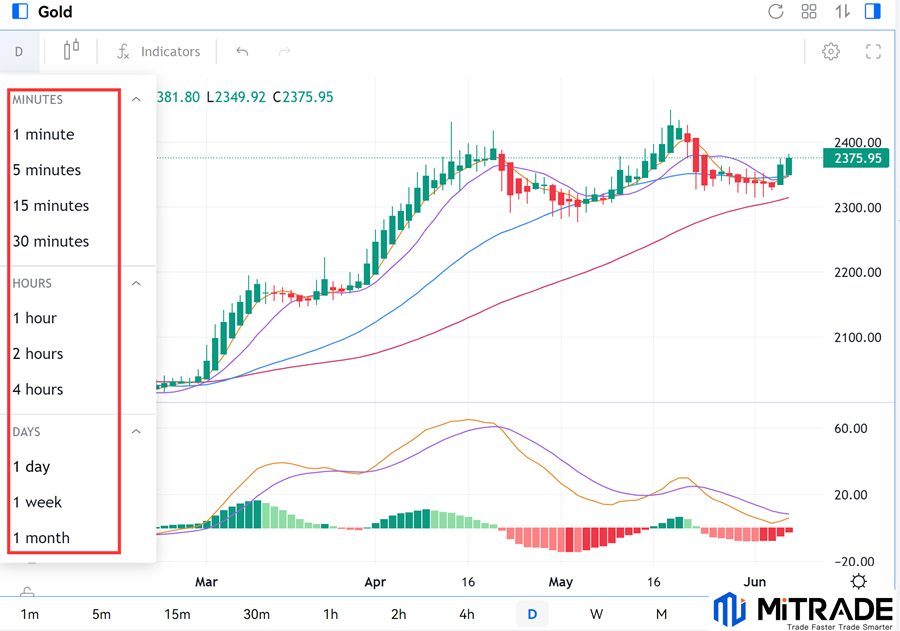
Gold candlestick chart
1 minute (M1)
5 minutes (M5)
15 minutes (M15)
30 minutes (M30)
1 hour (H1)
4 hours (H4)
Daily (D1)
Weekly (W1)
Monthly (M1)
When you switch from a larger time frame to a smaller one, the number of candles will increase. This is similar to zooming in on the chart.
For example, if you are viewing the H1 chart, which is the 1-hour chart, then each candle represents 1 hour. If you switch to the M15 chart, you will see 4 candles for that same 1-hour period, as 4 M15 candles make up 1 H1 candle.

 0 commission, low spreads
0 commission, low spreads Diverse risk management tools
Diverse risk management tools Flexible leverages and instant analysis
Flexible leverages and instant analysis Practice with $50,000 risk-free virtual money
Practice with $50,000 risk-free virtual money 
3. Guide to Using Japanese Candlestick Charts Online
The chart for that product will appear after you select it. You can choose the appropriate chart types for yourself to get the most accurate analysis.
The charts available on Mitrade include: Bar Chart, Candlestick Chart, Hollow Candlestick Chart, Line Chart, Area Chart, Moving Average, and Heikin Ashi.
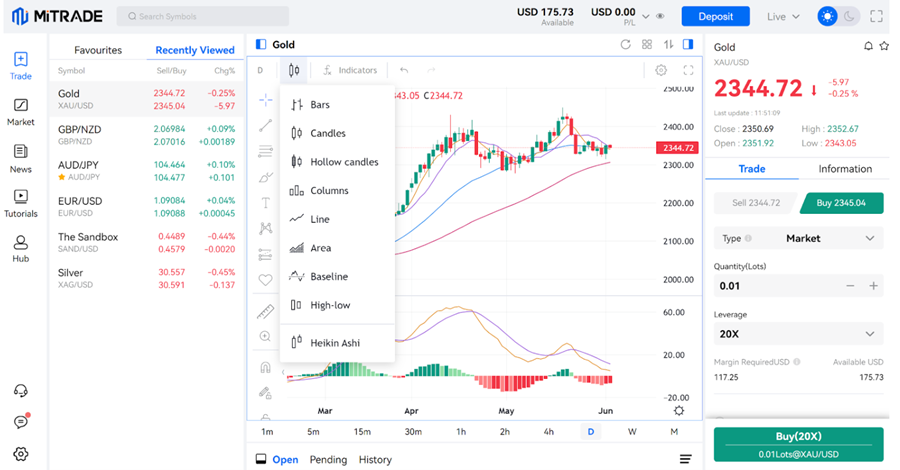
Try to Read Candlestick Charts Now
My advice for you all is to never "go all in". Mitrade offers a wide range of products to trade and excellent risk management tools, but if you "go all in" on one product, it could wipe out your capital.
Therefore, divide your capital into smaller portions, maximize the diversification of your investment portfolio, and this way you will limit your chances of total loss and go the distance with Mitrade.
4. Top 12 Must Know Candlestick Patterns
6 Bullish Candlestick Patterns
Hammer Pattern
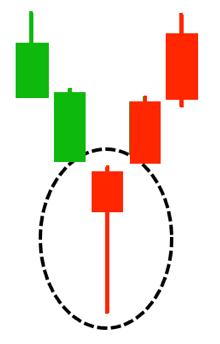
The Hammer Pattern is created when the open, high, and close prices are all close together. Additionally, the lower shadow is at least twice as long as the body of the candle. When prices are high and the close is near the open, a strong bullish Hammer candle is formed because the market has pushed the high higher than the open.
Conversely, when the open and high are the same, the Hammer pattern is considered less bullish, as it may not be able to return to the opening price.
The long lower shadow suggests the market tested support and when support was found, prices were pushed higher, close to the opening level. Therefore, the downtrend has been rejected.
Inverted Hammer Pattern
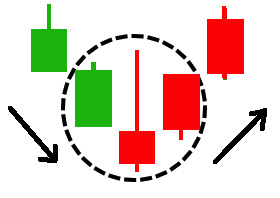
The Inverted Hammer pattern mainly occurs at the bottom of a downtrend and can act as a warning of a potential price reversal.
The Inverted Hammer is formed when the open, low, and close prices are all close together. Additionally, it has a long upper shadow at least twice the length of the body.
When the low and open are the same, the bullish Inverted Hammer is formed and is considered a stronger sign of an impending rise compared to when the low and close are equal.
After an extended downtrend, the formation of an Inverted Hammer suggests the market is turning higher as prices are hesitantly moving down by making a significant intraday increase.
Bullish Engulfing Pattern
The Bullish Engulfing candlestick pattern is a reversal pattern that occurs at the bottom of a downtrend.
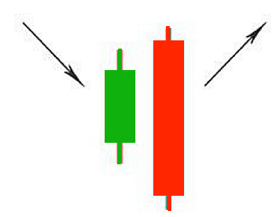
The pattern consists of two candles:
A small bearish candle (Day 1)
A larger bullish candle (Day 2)
Typically, the bearish candle on Day 1 has a smaller body and can fit within the bullish candle on Day 2.. On Day 2, the market gaps down;
However, the bears cannot go very far before the bulls take over and push the price higher, filling the gap and driving the price above the previous day's open.
Piercing Line
The Piercing Line is considered a bullish reversal pattern, similar to the Bullish Engulfing pattern.
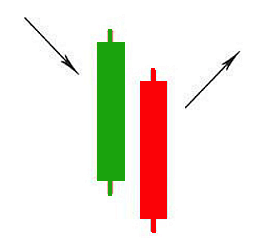
There are two components:
A bearish candle (day 1)
A bullish candle (day 2)
The Piercing Line occurs when a bullish candle on day 2 closes above the midpoint of the previous day's bearish candle.
Typically, there is a significant difference between the closing price of the first candle and the opening price of the second candle. Strong buying pressure is evident as the price rises above the average price of the previous day.
Morning Star
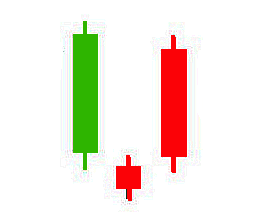
The Morning Star pattern consists of:
A large bearish candle (day 1)
A small bullish or bearish candle (day 2)
A large bullish candle (day 3)
On day 1, the downtrend often creates a new low.
Day 2 begins with a downward gap, however, the price is not pushed much lower. The day 2 candle is fairly small and may be bullish, bearish, or neutral.
Day 3 begins with an upward gap and the market may push the price even higher, erasing the losses of day 1.
Three White Soldiers
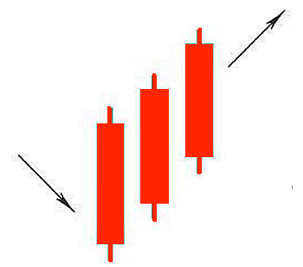
Over three days, the Three White Soldiers pattern consists of a series of long green (or white) candles with small shadows.The opening and closing prices of the candles gradually increase from one day to the next.
This is a very strong bullish signal that occurs after a downtrend, and indicates a steady increase in buying pressure.
6 Bearish Candlestick Patterns
The Hanging Man Pattern
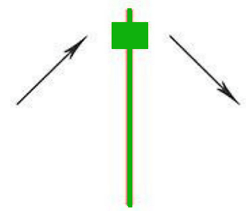
A Hanging Man candle's formation is considered a bearish sign.This pattern mainly occurs at the end of an uptrend and can serve as a warning of a potential downward reversal. The Hanging Man pattern is created when the opening price, highest price, and closing price are all relatively close to each other.
Additionally, there is a long lower shadow at least twice the length of the real body. After a prolonged uptrend, the formation of a Hanging Man pattern signals that the price is hesitating and has declined significantly during the day.
Bearish Engulfing Pattern
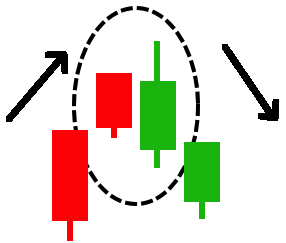
The pattern consists of two candles:
A small bullish candle (Day 1)
A larger bearish candle (Day 2)
The real body of the Day 1 candle can be contained within the real body of the Day 2 bearish candle. The market advanced on Day 2;
However, the price was not pushed much higher before being pushed lower, closing below the previous day's open (a bearish sign).
Evening Star Pattern
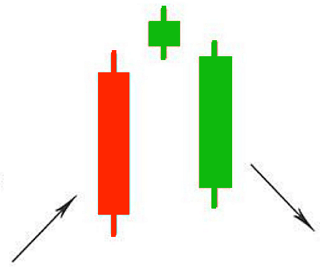
The pattern consists of three candles: a large bullish candle (Day 1), a small bullish or bearish candle (Day 2), and a large bearish candle (Day 3). On Day 1, new highs were established.
Day 2 opens with a gap up; however, the price is not pushed much higher. Day 3 opens with a gap down (a bearish signal), and the price may be pushed lower, often erasing the gains from Day 1.
Shooting Star Pattern
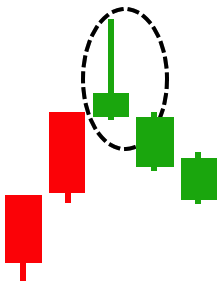
The Shooting Star model is formed when the opening price, the lowest price, and the closing price are close to each other. Additionally, there is a long upper shadow, which is typically at least double the length of the candle body.
A strong bearish Shooting Star candle forms when the lowest price and the closing price are equal because the market may push the price higher again by closing below the opening price.
The long upper shadow of the Shooting Star candle indicates that the market has tested to find a resistance area and supply. When the market finds the price resistance area, the price begins to decline and ends the day near the opening price.
Three Black Crows Pattern
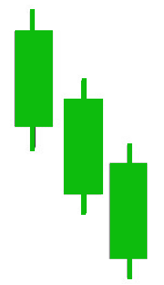
The Three Black Crows candlestick pattern consists of three consecutive long red candles with short or no shadows. Each day opens at a price similar to the previous day, but the selling pressure pushes the price lower with each closing.
This pattern is the beginning of a downtrend, as the sellers have overpowered the buyers for three consecutive trading days.
Dark Cloud Cover Pattern
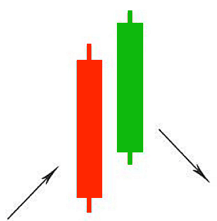
There are two components of the Dark Cloud Cover model:
A bullish candle (Day 1)
A bearish candle (Day 2)
The Dark Cloud Cover pattern occurs when a Day 2 bearish candle closes with a price below the midpoint of the Day 1 candle body.
Additionally, the price gap on Day 2 is only to fill the space and closes significantly into the Day 1 price range. The rejection of the upward gap is a bearish sign, but the retreat to the previous day's gain further enhances the bearish sentiment.
4 Continuation Candlestick Patterns: These candlestick patterns not only indicate a change in market direction, but also help traders identify a period of rest in the market, when there is market hesitation or neutral price fluctuations.
5. Limitations of the Candlestick patterns
The Candlestick pattern also has a few limitations besides its usefulness as a financial analysis tool. The limitations of the Candlestick patterns are listed below:
● Needs Confirmation: This is a rather obvious drawback of the Candlestick patterns. Just a 30-second delay can affect the open and close prices of the candle, changing its shape.
If you are a traditional price action trader and use basic candlestick patterns, the closing price is an essential part. The delay can affect the open price of the next candle, leading to a vicious cycle.
● Numerous Patterns: There are a large number of candlestick patterns and their combinations. As we listed in the previous section, Japanese Candlestick patterns are very diverse and quite numerous. Their combinations can confuse traders.
● Cannot Predict Future Trends: Japanese Candlestick patterns only represent prices over a specific time period in the present. It cannot depict price trends and also cannot determine the current market trend.
6. Conclusion
In conclusion, Japanese candlestick patterns offer a powerful tool for financial analysis, providing a visual representation of price movements that can help traders identify potential trends, reversals, and continuations. By understanding the fundamental principles of these patterns and their practical application, traders can improve their decision-making process and navigate the complex world of financial markets more effectively.
The Candlestick pattern helps traders assess the sentiment of surrounding traders about a stock or other asset in order to make short-term predictions about its trend.Key patterns can be used in conjunction with other technical analysis tools to gain a clearer picture of market direction and make more informed trading decisions.
Before making any trading decisions, it is important to equip yourself with sufficient fundamental knowledge, have a comprehensive understanding of market trends, be aware of risks and hidden costs, carefully consider investment targets, level of experience, risk appetite, and seek professional advice if necessary.
Furthermore, the content of this article is solely the author's personal opinion and does not necessarily constitute investment advice. The content of this article is for reference purposes only, and readers should not use this article as a basis for any investment decisions.
Investors should not rely on this information as a substitute for independent judgment or make decisions solely based on this information. It does not constitute any trading activity and does not guarantee any profits in trading.
If you have any inquiries regarding the data, information, or content related to Mitrade in this article, please contact us via email: insights@mitrade.com. The Mitrade team will carefully review the content to continue improving the quality of the article.












